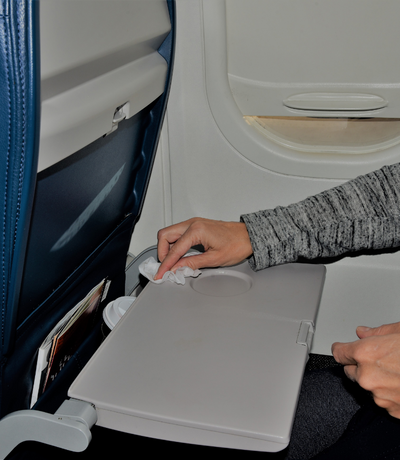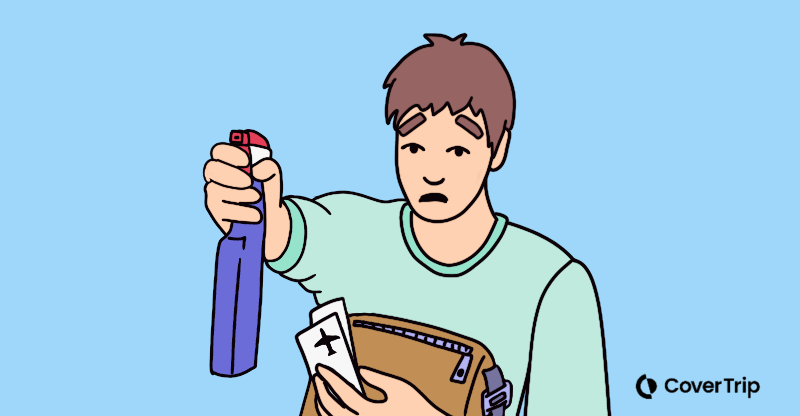Wipe down the germiest travel surfaces, or else
4 August 2022
Nothing can ruin your trip like coming down with something that keeps you from enjoying your plans. Waving your family goodbye so you can head back under the covers might sound great on a rainy weekday back home. It’s a special kind of torture, however, when you’ve put time, money, and effort into planning the perfect trip.
While I’ve been fairly blasé about germs in the past, the last two years taught me – and many others like me – to be a little more cautious. For those who were germ-cautious before COVID, I have more empathy for how you’ve felt all along.
When I recently ran across a press release published by Lysol®, I was curious and a little dubious. After all, you have to consider the source, right? But when I read that a team of scientists used a method I hadn’t heard about to measure contamination levels on surfaces in 15 hotels, 10 planes, and 1 airport across the US, I was intrigued.
To test each surface, the scientists used something called ATP (adenosine triphosphate) analysis. Essentially, it involves rubbing pre-moistened cotton swabs on surfaces and then placing them into readers to measure bacteria levels.
Important clarification! The test does not detect viruses. Instead it gives a reading of all bacteria (good and bad) on the surface.
While ATP testing cannot detect viruses, many of the prevention tips we’ll talk about in a moment are the same. Catching the flu, monkeypox, or COVID isn’t your only travel health risk. Catching a cold, strep throat, or a stomach bug could just as easily derail your travel plans.
So, what do you need to know and do to protect yourself and help your traveling companions avoid bacteria while traveling? Read on to find out the consistently germiest places.

Airport check-in
The top three dirtiest places in airport check-in lobbies are:
- Kiosk check-in touch pads
- Check-in countertop surfaces
- Baggage drop countertop surfaces
Essentially, all the places you have to touch to check in and hand over your luggage before you fly.
What should you do? Carry a small pack of sanitizing wipes and wipe down the surfaces as you move through the airport check-in process. Once you’re on the other side, and before you go to your gate, wash your hands thoroughly.
Pro tip: viruses, including coronaviruses, can live on metal, plastic, and glass surfaces for up to 5 or even 9 days depending on temperature and humidity levels. Wiping surfaces with alcohol-based cleaning fluids will properly disinfect those surfaces.
At your plane seat
The three germiest spots to avoid when you reach your seat are:
- The seat buckles and window shade handles (these two tied)
- Tray table latches (heck, I say the whole tray table!)
- Overhead air vent dials
Essentially, all the places you’ll have to touch to get settled in and be comfy. Ew!
What should you do? Remember when airline staff handed out sanitizing wipes as you boarded a flight? Well, the best thing about that is it got people over the hump of thinking it’s weird to wipe things down. So, whip out those wipes again and wipe down everything – including the armrest while you’re at it.
Pro tip: Smile and offer others in your row a wipe too. They just might appreciate it, and it feels less weird when more people are in on it.
At the hotel lobby
The top three dirtiest places in hotel lobbies are:
- Elevator buttons
- Luggage cart handrails
- Front desk surfaces, bathroom doors, and handrails (another tie)
Of course, these are all the places you access to check in, get your swipe key, and head upstairs. Will it never end?
What should you do? Discreetly whip out those wipes and wipe down everything as you check in. Bonus points if you do it with a big smile on your face.
In your hotel room
The top three germy places in hotel rooms are:
- Handles on toilets
- Television remote and doorknobs (another tie)
- Desk surfaces, refrigerator handles, and the surface of the nightstand (a final three-way tie)
We’re rounding the final stretch here.
What should you do? Set your luggage down at the door of your hotel room, then whip out a sanitizing wipe and clean the door handle. After you enter, set your luggage down again and it’s a race around the room with a fresh wipe to clean all the handles, surfaces, and the remote.
Now, go wash your hands and you’re done. Whew!
Related topics
Damian Tysdal is the founder of CoverTrip, and is a licensed agent for travel insurance (MA 1883287). He believes travel insurance should be easier to understand, and started the first travel insurance blog in 2006.
